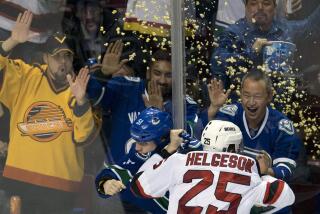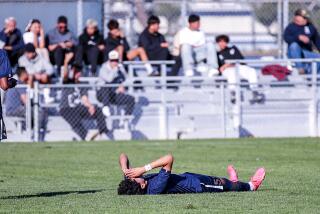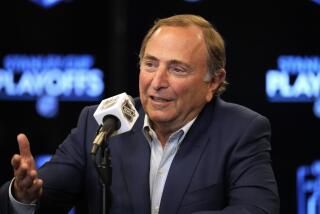NHL’s Rules of the Goad
Hockey is governed by a red line, two blue lines and an invisible line that separates “good” hits -- those made to win the puck, take a player out of a play or prevent a goal -- from those intended to injure or exact retribution for slights real or imagined.
Vancouver Canuck winger Todd Bertuzzi crossed that line on March 8. Eager to avenge a hit leveled against a teammate by Colorado rookie Steve Moore three weeks earlier but unable to goad Moore into a fight, Bertuzzi struck Moore with a blindside punch to the head and dropped him face-first to the ice.
Moore suffered three fractured vertebrae in his neck, stretched nerves in his neck, a concussion, facial cuts and bruises. He was released from a Denver hospital Monday and his hockey future remains uncertain.
The NHL suspended Bertuzzi for the rest of this season plus the playoffs and required him to petition Commissioner Gary Bettman for reinstatement. He might also face assault charges, pending a Vancouver police investigation that is expected to continue for several weeks.
The incident ignited a firestorm of criticism of the NHL’s tolerance of fighting and rough play. But many players, observers and officials say Bertuzzi’s attack was an indirect consequence of the instigator rule, which was adopted in 1992 as part of the league’s effort to minimize the fighting that bloodied its image in the 1970s.
In its current form, the instigator rule mandates penalties and suspensions for players who start fights and accumulate instigator infractions over the course of a season. However, many say it has made players reluctant to retaliate against cheap shots for fear they’ll get an instigator penalty and put their teams at a disadvantage.
Some players, aware they can act almost with impunity because the victim is afraid of being adjudged the instigator of a fight, take ugly hits to a new level -- as Bertuzzi did against Moore. In this case, Bertuzzi was ejected. Had he been called for a lesser foul -- slashing or hooking -- Bertuzzi would have been subject to a two-minute minor or five-minute major penalty but allowed to continue, since he had not instigated a fight.
“Was it beyond the line? Yeah. Would it have happened 10 years ago? No,” said Hall of Fame goaltender Grant Fuhr, a five-time Stanley Cup winner with the Edmonton Oilers. “[Twelve] years ago it would have been settled the same night. There was no instigator penalty, so it gets solved.
“Look back. If someone ran over [Wayne] Gretzky, you think it would have been settled there and then? There’s probably a good chance that Marty [McSorley] or [Dave] Semenko would have gone after the guy.”
Bertuzzi’s punch was retribution for Moore’s un-penalized shoulder hit of Vancouver’s Markus Naslund in a Feb. 16 game. Naslund was caught unaware and suffered a concussion but said Moore had gotten him cleanly. The NHL agreed.
That didn’t stop Bertuzzi from sucker-punching Moore on March 8 late in a game the Canucks would lose, 9-2. Moore fell face-first to the ice with the 245-pound Bertuzzi atop him.
“It was almost like somebody being hunted down, and how uncomfortable an image it was,” Hall of Fame goalie Ken Dryden, now vice chairman of the Toronto Maple Leafs, said during a Canadian hockey telecast last weekend. “It was a little like a National Geographic special and watching the lion and the antelope and how unfair it was ... the way he had absolutely no reason to believe anything was going to happen.”
The incident awakened a debate begun four years ago, when McSorley, then with the Boston Bruins, struck Canuck forward Donald Brashear over the head with his stick in a game also played at Vancouver.
As with Bertuzzi and Moore, one player wanted to fight and one didn’t, the victim suffered a head injury and the aggressor was suspended for the rest of the season. McSorley was charged with assault with a weapon and convicted; he got an 18-month conditional discharge and never applied to play in the NHL again.
“We can’t be so naive as to say that our conduct on the ice rises to a level that’s above the law,” said Stu Grimson, formerly an NHL tough guy who now is a law student at the University of Memphis. “Sport is not above the laws of society.”
However, setting the laws that regulate hockey has proven tricky.
In the 1970s, during the reign of the Philadelphia Flyers’ Broad Street Bullies, most teams had at least one tough guy whose job was to go after a skillful player on the other team. If the opponent responded and a fight broke out that led to penalties for both sides, the enforcer’s team would lose a player of limited skills, but the opposing team might lose one of its top scorers.
“The reason we put the instigator rule in the game was to calm those situations down,” said Bryan Murray, general manager of the Mighty Ducks. “The people that were out there just looking for a fight on a regular basis paid the consequences.”
Teams such as Gretzky’s Oilers sent out muscular players to protect their stars, a role McSorley and Semenko played well. And if one team’s enforcer fought another, it was considered acceptable, a release of tension.
“The players used to police themselves,” Murray said, “and I think you get respect by knowing that if you do something that’s uncalled for in the game or vicious in the game, that there was payback. And the payback was that you had to face various people on the opposite side.”
Not anymore. As a result, many executives and players say they’ve seen more ugly hits from behind and to backs and heads because the instigator penalty deters opponents from responding. NHL officials say the effectiveness of the instigator rule will be discussed as part of the upcoming collective bargaining talks.
But for now, grudges can fester, as with Bertuzzi.
After Moore’s hit knocked Naslund out of the game Feb. 16 at Denver, the teams had played an incident-free 5-5 tie on March 3 at Denver. But in the next game, no doubt frustrated by his team’s imminent loss, Bertuzzi erupted.
“It would have been eliminated if they had just fought in the second game,” said Kings forward Sean Avery, who is second in the NHL with 240 penalty minutes. “Have a five-on-five fight and get it over with. That’s how you should deal with it. Put your five toughest guys on the ice and let them fight. Eventually, the anger is going to burn off.
“It didn’t happen and just kept building and building. Then you have a 9-2 blowout game.”
Fuhr agreed, saying Bertuzzi plays “with an edge” because he knows he can provoke opponents and not fear reprisal.
“It used to be that scorers scored and checkers checked. Now you’ve got guys who are not normally aggressive and tough being aggressive and tough because there are no consequences,” Fuhr said.
But the Bertuzzi-Moore incident had unhappy consequences for the NHL’s image.
The punch was replayed on TV for days. U.S. network news shows, which regard hockey as a curiosity if they regard it at all, roundly condemned the NHL for allowing fighting. To Murray, that mixed separate issues. “That was not a fight. That was thuggery, really,” he said.
Yet the thuggery hasn’t stopped.
On Saturday, Toronto’s Wade Belak struck Colorado’s Ossi Vaananen over the head with his stick and was suspended for his team’s last six games plus two playoff games. Belak claimed he’d lost his balance and hit Vaananen accidentally.
On Sunday, veteran Mark Messier of the New York Rangers speared Pittsburgh’s Martin Strbak and was suspended for two games. Colorado’s Chris Simon was suspended for two games for kneeing Dallas Sergei Zubov on Monday.
“Hockey today is at risk of becoming an extreme sport,” Dryden said during a symposium on the future of hockey.
Fights and fighting have decreased over the last two decades because of stiff penalties that have virtually ended bench-clearing brawls, but newspaper and Internet columnists from Maine to Malibu declared the Bertuzzi incident symbolized a sport so brutish and unappealing that it would not be missed if a labor dispute delays or cancels play next season.
“When it’s portrayed on CNN or by Katie Couric it looks like some ugly beast that’s crawled out from under the stairs and you say, ‘This doesn’t belong in society,’ ” Grimson said.
“I don’t condone what Todd Bertuzzi did, but you have to appreciate the context that kind of act comes from. If you don’t know the sport and you throw the 15-second clip on CNN all day, it sounds simplistic to say it’s presented out of context. But that’s really what happens.”
Murray sees nothing wrong with a fight between two willing opponents in a game that’s played between increasingly larger players skating at a fast pace in a confined space. He also contends baseball can be a more vicious pastime.
“People throw at your head with a baseball at 100 mph. That’s their intimidation and their payback,” he said. “If you do it to a good hitter, then the next time up that pitcher is going to get decked. But ours is a real obvious thing, where you grab a person and you have a fight.”
Bertuzzi apologized to Moore, but the damage was done. Moore’s spinal cord was uninjured but recovery from a concussion is unpredictable; Bertuzzi’s absence from the Canucks’ lineup will surely hinder the team’s drive for the Stanley Cup. And to a hockey player, there’s no greater punishment than to miss the playoffs.
“The difference between a hockey player and a serial killer is a hockey player can realize what he’s done and can stop it,” Avery said. “Todd Bertuzzi will never ever do that again, and I hate Todd Bertuzzi with a passion, but something like this isn’t going to happen again.”
The NHL can only hope he’s right. “I think the [players’] union and the league together have got to help every player that’s in the league understand that these things affect your life. They affect your career,” Murray said.
“Marty McSorley -- you can’t tell me that’s not brought up almost daily to him. And now Todd Bertuzzi, a star in our league, his life will be affected forever and ever because it will always be referred to as something that happened in our game that got notoriety that we don’t really need.”
*
(BEGIN TEXT OF INFOBOX)
Regular-Season Fights
NHL games with and without fighting majors:
*--* Total Games Games Game % Games W/1+ W/none no fight 1979-80 840 363 477 56.8 1980-81 840 408 432 51.4 1981-82 840 401 439 52.3 1982-83 840 388 452 53.8 1983-84 840 441 399 47.5 1984-85 840 421 419 49.9 1985-86 840 478 362 43.1 1986-87 840 476 364 43.3 1987-88 840 500 340 40.5 1988-89 840 452 388 46.2 1989-90 840 444 396 47.1 1990-91 840 457 383 45.6 1991-92 880 471 409 46.5 1992-93 1,008 426 582 57.7 1993-94 1,092 518 574 52.6 1994-95 624 310 314 50.3 1995-96 1,066 490 576 54.0 1996-97 1,066 554 512 48.0 1997-98 1,066 517 549 51.5 1998-99 1,107 436 671 60.6 1999-00 1,148 417 731 63.7 2000-01 1,230 469 761 61.9 2001-02 1,230 519 711 57.8 2002-03 1,230 464 766 62.3 2003-04 1,052 452 600 57.0
*--*
GAMES w/1+ = games with one-or-more fighting majors GAMES w/NONE = games with no fighting majors PCT GMS NO FIGHT = percentage of all games in which there were no fighting majors
*
Playoff Fights
Stanley Cup playoff games with and without fighting majors:
*--* Total Games Games Game % games W/1+ W/none no fight 1988 84 43 41 48.8 1989 82 27 55 67.1 1990 85 21 64 75.3 1991 92 25 67 72.8 1992 86 14 72 83.7 1993 85 7 78 91.8 1994 90 15 75 83.3 1995 81 7 74 91.4 1996 86 14 72 83.7 1997 82 10 72 87.8 1998 82 9 73 89.0 1999 86 3 83 96.5 2000 83 9 74 89.2 2001 86 4 82 95.3 2002 90 5 85 94.4 2003 89 6 83 93.3
*--*
GAMES w/1+ = games with one-or-more fighting majors GAMES w/NONE = games with no fighting majors PCT GMS NO FIGHT = percentage of all games in which there were no fighting majors
*
Times staff writer Mike Bresnahan contributed to this report.
More to Read
Go beyond the scoreboard
Get the latest on L.A.'s teams in the daily Sports Report newsletter.
You may occasionally receive promotional content from the Los Angeles Times.







